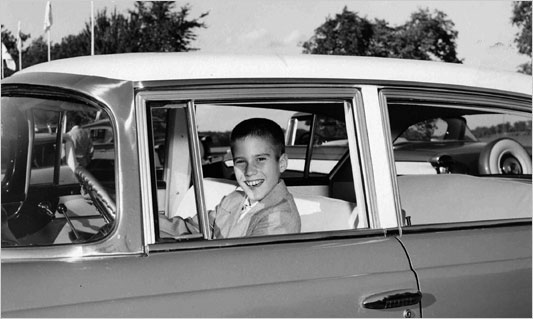|
The Importance of Mitt’s Rambler
 Mitt Romney behind the wheel of a Nash in 1957. (Courtesy of Romney Family/Associated Press)
By now you might have seen the Associated Press report on the Presidential candidates and their first cars. Hillary Clinton: A ‘63 Oldsmobile Cutlass. John Edwards: Plymouth Duster. Barack Obama: Grandfather’s Ford Granada. Bill Richardson: Secondhand Ford Mustang. Rudy Giuliani: A used Dodge. Mike Huckabee: Mercury Montego. John McCain: ‘58 Corvette. Mitt Romney: A used ‘63 Rambler Classic. Fred Thompson: Red pickup. In the 1950s and ’60s, the Nash Ramblers, then simply Ramblers were small econocars, in comparison to the cruisers and bruisers produced by the Big Three. They’ve even been called the first compact cars and mid size cars. From 1954 to 1962, Mr. Romney’s father, George, was the chief executive of American Motors, the company that built Ramblers and the even smaller Metropolitans. In 1959, he appeared on the cover of Time magazine for his efforts in getting the American public to trade in their large cars for the compacts that American Motors built. The title of the story was “Dinosaur Hunter.”
As you can see, it’s a pretty wonderfully written profile of the man who would go on to become the Governor of Michigan, and later try for the Presidency (losing the 1968 Republican nomination to Richard Nixon). It also contains interesting analysis of the automotive landscape at the time.
Sound familiar? Remember, this was written in 1959. And it’s scary
(and depressing) for several reasons, Back in the early 60's Detroit complained that it could not build a sufficiently profitable small car. It’s the same argument we hear today. You would think that they would have figured out how to build a profitable small car by now, especially since over the same amount of time, Toyota has gone from selling a single model in the United States to matching General Motors in market share. And Honda has gone from a motorcycle manufacturer to building some of the most popular cars on American roads. The Time article ended on a positive note. Even though the Big Three moved some resources into building compact cars, George Romney sounded optimistic about AMCs future. “We have greater freedom and flexibility of operation,” he said. “We’re leaner. We’re harder. We’re faster. I’ve seen halfbacks, out in the clear, trip and fall flat with a sure touchdown in sight. That sort of thing could happen to anybody. But I don’t intend to let it happen to us.” George
didn’t let American Motors fail. His successor did, by
putting the Rambler on the back burner and signing off on bigger and
bigger cars through the 1960s and ’70s. We know what happened next, as
a fuel crisis dominated the late-1970s, American Motors went down the
tubes (along with the Big Three’s sales) and American drivers turned to
Toyotas and Hondas. There are those who will argue that AMC had
the Gremlin, Hornet and Pacer. True, but the Pacer was heavy and
offered poor fuel mileage, and AMC let the Gremlin and Hornet wilt on
the vine while they pored their development money into the Pacer and
Matador Coupe. The wise investment would have been to freshen and
lighten the Gremlin / Hornet Tandem, and down size the Matador /
Ambassador sharing components to cut costs with Gremlin / Hornet where
possible, just like Mr. Romney had done back in the early sixties with
the American / Classic / Ambassador. |
